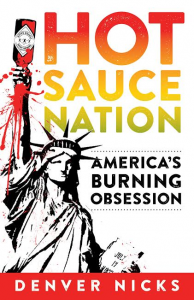 And since having your hot sauce with fats increases its health benefits, you’ll want to add “Butter: A Rich History” by Elaine Khosrova to your cart. In this book, you’ll learn the history of that which goes on toast and in tarts; how butter is made around the world; how it’s eaten; and its importance to many cultures. Bonus: recipes, so you can enjoy a little extra butter in your meal.
And since having your hot sauce with fats increases its health benefits, you’ll want to add “Butter: A Rich History” by Elaine Khosrova to your cart. In this book, you’ll learn the history of that which goes on toast and in tarts; how butter is made around the world; how it’s eaten; and its importance to many cultures. Bonus: recipes, so you can enjoy a little extra butter in your meal.Some Like It With Spice But America ’s Love It With Hot Sauce
By Terri Schlichenmeyer
All the things you love will be on your table this holiday.
Steaming mashed potatoes with a dollop of butter. Turkey or ham, fresh from the oven. Green bean casserole, waiting for the toasted onions. Everything you love, piping hot and, with “Hot Sauce Nation” by Denver Nicks, you can turn up the heat even more.
Picture in your mind the first time someone ate a chili.
Denver Nicks imagines it was a cave-teenager who ate the berry, perhaps figuring that if birds could consume chilies, they were safe for anyone to eat. Red-faced, eyes watering, mouth afire, he must’ve turned to his cave-teen buddy who, of course, couldn’t wait to eat one, too.
Truly, we love our hot stuff; its sales outdo that of every other condiment these days. We’ve loved it at least since 6000 BCE, which is when chili bits were left behind in a grave. We’ve loved it since Columbus brought chilies to the Old World , thinking they were odd-tasting pepper. We’ve loved it since a bloodthirsty conquistador brought chili plants to the America ’s southwest in the late 1590s, and Africans brought seeds with them on the Middle Passage.
Chilies are measured by the Scoville Heat Unit (SHU), a test created more than a century ago. A regular garden-variety green pepper rates a rather boring 0 SHU. Tabasco is 5,000 SHU. Capsaicin gets an incinerating 16,000,000 SHU but milder heats are compelling; we can’t get enough of that pain, says Nicks, in part because its burn releases dopamine and can create a thrilling hot-knife illusion for the tongue. Chilies, he says, can also clear the sinuses and bring on a kind of high. Hot-cha-cha.
Acquired taste or not, Nicks says that our North American passion for heat is growing. The popularity of Mexican, Indian, and Chinese food, although our versions are “a kind of imitation cuisine,” helps increase the trend toward hot, spicy foods in restaurants and snack foods. The number of near-combustible consumables is increasing, and on a spicy road-trip, Nicks found that regional preferences just feed the need.
“Delicious, healthy…” he says about hot sauce. “… how’s that for a miracle food?”
Everywhere you go these days, it seems, you can find food that burns your tongue and makes your hands fan. But why now? In “Hot Sauce Nation,” you’ll see.
Spicy food, as author Denver Nicks shows, is addicting and he’s got the science to prove it. He’s also got the culinary history, taking us on a round-the-world tour to show how we’ve gone from blah to blasting our palates with flames. Readers who love hot-and-spicy will find themselves wishing they’d been along with Nicks on his road trips; he tried the hottest chilies, spiciest sauces, and took the biggest challenges, and his mouth- (and eye-) watering descriptions makes us want that, too.
Alas, there are no recipes inside this book but that won’t matter to foodies or fans of flaming food. If you crave a taste that nearly melts your teeth, “Hot Sauce Nation” will further ignite your interest.
 And since having your hot sauce with fats increases its health benefits, you’ll want to add “Butter: A Rich History” by Elaine Khosrova to your cart. In this book, you’ll learn the history of that which goes on toast and in tarts; how butter is made around the world; how it’s eaten; and its importance to many cultures. Bonus: recipes, so you can enjoy a little extra butter in your meal.
And since having your hot sauce with fats increases its health benefits, you’ll want to add “Butter: A Rich History” by Elaine Khosrova to your cart. In this book, you’ll learn the history of that which goes on toast and in tarts; how butter is made around the world; how it’s eaten; and its importance to many cultures. Bonus: recipes, so you can enjoy a little extra butter in your meal.




